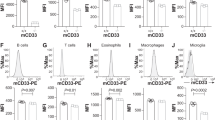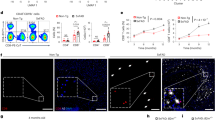Abstract
The human CD4 molecule (hCD4) is expressed on T lymphocytes and macrophages and acts as a key component of the cellular receptor for HIV. At baseline, hCD4 transgenic mice expressed hCD4 on microglia, the resident mononuclear phagocytes of the brain, and showed no neuronal damage. Activation of brain microglia by peripheral immune challenges elicited neurodegeneration in hCD4 mice but not in nontransgenic controls. In post-mortem brain tissues from AIDS patients with opportunistic infections, but without typical HIV encephalitis, hCD4 expression correlated with neurodegeneration. We conclude that hCD4 may function as an important mediator of indirect neuronal damage in infectious and immune-mediated diseases of the central nervous system.
This is a preview of subscription content, access via your institution
Access options
Subscribe to this journal
Receive 12 print issues and online access
$209.00 per year
only $17.42 per issue
Buy this article
- Purchase on Springer Link
- Instant access to full article PDF
Prices may be subject to local taxes which are calculated during checkout
Similar content being viewed by others
References
Crocker, P.R., Jefferies, W.A., Clark, S.J., Chung, L.P. & Cordon, S. Species heterogeneity in macrophage expression of the CD4 antigen. J. Exp. Med. 166, 613–618 (1987).
Tourvieille, B., Gorman, S.D., Field, E.H., Hunkapiller, T. & Parnes, J.R. Isolation and sequence of L3T4 complementary DNA clones: expression in T cells and brain. Science 234, 610–614 (1986).
Maddon, P.J. et al. Structure and expression of the human and mouse T4 genes. Proc. Natl. Acad. Sci. USA 84, 9155–9159 (1987).
Clapham, P.R. et al. Soluble CD4 blocks the infectivity of diverse strains of HIV and SIV for T cells and monocytes but not for brain and muscle cells. Nature 337, 368–370 (1989).
Forte, P. et al. Human CD4 produced in lymphoid cells of transgenic mice binds HIV gp120 and modifies the subsets of mouse T-cell populations. Immunogenetics 38, 455–459 (1993).
Houlgatte, R. et al. HLA class II antigens and the HIV envelope glycoprotein CP120 bind to the same face of CD4. J. Immunol. 152, 4475–4488 (1994).
Killeen, N., Sawada, S. & Littman, D.R. Regulated expression of human CD4 rescues helper T cell development in mice lacking expression of endogenous CD4. EMBO J. 12, 1547–1553 (1993).
Vignali, D.A., Doyle, C., Kinch, M.S., Shin, J. & Stominger, J.L. Interactions of CD4 with MHC class II molecules, T cell receptors and p56lck. Philos. Trans. R. Soc. Land. B. Biol. Sci. 342, 13–24 (1993).
Gendelman, H.E., Lipton, S.A., Tardieu, M., Bukrinsky, M.I. & Nottet, H.S.L.M. The neuropathogenesis of HIV-1 infection. J. Leukocyte Biol. 56, 389–398 (1994).
Giulian, D. et al. Study of receptor-mediated neurotoxins released by HIV-1 -infected mononuclear phagocytes found in human brain, J. Neurosci. 16, 3139–3153 (1996).
Giulian, D. et al. Specific domains of p-amyloid from Alzheimer plaque elicit neuron killing in human microglia. J. Neurosci. 16, 6021–6037 (1996).
Perry, V.H., Hume, D.A. & Gordon, S. Immunohistochemical localization of macrophages and microglia in the adult and developing mouse brain. Neuroscience 15, 313–326 (1985).
Gordon, S. et al. Antigen markers of macrophage differentiation in murine tissues. Curr. Top. Microbiol. Immunol. 181, 1–37 (1992).
Ulevitch, R.J. & Tobias, P.S. Recognition of endotoxin by cells leading to transmem-brane signaling. Curr. Opinion Immunol. 6, 125–130 (1994).
Buttini, M., Limonta, S. & Boddeke, H.W.G.M. Peripheral administration of lipopolysaccharide induces activation of microglial cells in rat brain. Neurochem. Intl. 29, 25–35 (1996).
VanDam, A.M., Brouns, M., Louisse, S. & Berkenbosch, F. Appearance of inter-leukin-1 in macrophages and in ramified microglia in the brain of endotoxin-treated rats: A pathway for the induction of non-specific symptoms of sickness?. Brain Res. 588, 291–298 (1992).
Masliah, E. et al. Spectrum of human immunodeficiency virus-associated neocortical damage. Ann. Neurol. 32, 321–329 (1992).
Masliah, E. et al. Cortical dendritic pathology in human immunodeficiency virus encephalitis. Lab. Invest. 66, 285–291 (1992).
Toggas, S.M. et al. Central nervous system damage produced by expression of the HIV-1 coat protein gp120 in transgenic mice. Nature 367, 188–193 (1994).
Traugott, U., Raine, C.S. & McFarlin, D.E. Acute experimental allergic encephalomyelitis in the mouse: Immunopathology of the developing lesion. Cell. Immunol. 91, 240 (1985).
Sobel, R.A., Tuohy, V.K., Lu, Z., Laursen, R.A. & Lees, M.B. Acute experimental allergic encephalomyelitis in SJL/J mice induced by a synthetic peptide of myelin pro-teolipid protein, J. Neuropathol. Exp. Neurol. 19, 468–479 (1990).
et al. Microglial involvement in experimental autoimmune inflammation of the central and peripheral nervous system. Glia 7, 50–59 (1993).
Budka, H. Cerebral pathology in AIDS: A new nomenclature and pathogenetic concepts. Curr. Opin. Neurol. Neurosurg. 5, 917–923 (1992).
Peudenier, S., Hery, C., Montagnier, L. & Tardieu, M. Human microglial cells: Characterization in cerebral tissue and in primary culture, and study of their susceptibility to HIV-1 infection. Ann. Neurol. 29, 152–161 (1991).
Lipton, S.A. HIV-related neuronal injury: Potential therapeutic intervention with calcium channel antagonists and NMDA antagonists. Mol. Neurobiol. 8, 181–196 (1994).
Toggas, S.M. & Mucke, L. Transgenic models in the study of AIDS dementia complex. Curr. Top. Microbiol. Immunol. 206, 223–241 (1996).
Mucke, L. & Buttini, M. Molecular basis of HIV-associated neurological disease, in Molecular Neurology (ed. Martin, J.) (Scientific American Medicine, New York, in the press).
Borrow, P., Cornell, J.L., Ruppe, M.D. & Mucke, L. Immunization-induced inflammatory infiltration of the central nervous system in transgenic mice expressing a microbial antigen in astrocytes. J. Neuroimmunol. 61, 133–149 (1995).
Streit, W.J. & Kreutzberg, G.W. Lectin binding by resting and reactive microglia. J. Neurocytol. 16, 249–260 (1987).
Author information
Authors and Affiliations
Corresponding author
Rights and permissions
About this article
Cite this article
Buttini, M., Westland, C., Masliah, E. et al. Novel role of human CD4 molecule identified in neurodegeneration. Nat Med 4, 441–446 (1998). https://doi.org/10.1038/nm0498-441
Received:
Accepted:
Issue Date:
DOI: https://doi.org/10.1038/nm0498-441
This article is cited by
-
Mapping quantitative trait loci for T lymphocyte subpopulations in peripheral blood in swine
BMC Genetics (2011)
-
The shifting patterns of HIV encephalitis neuropathology
Neurotoxicity Research (2005)
-
HIV-infected subjects with the E4 allele for APOE have excess dementia and peripheral neuropathy
Nature Medicine (1998)



